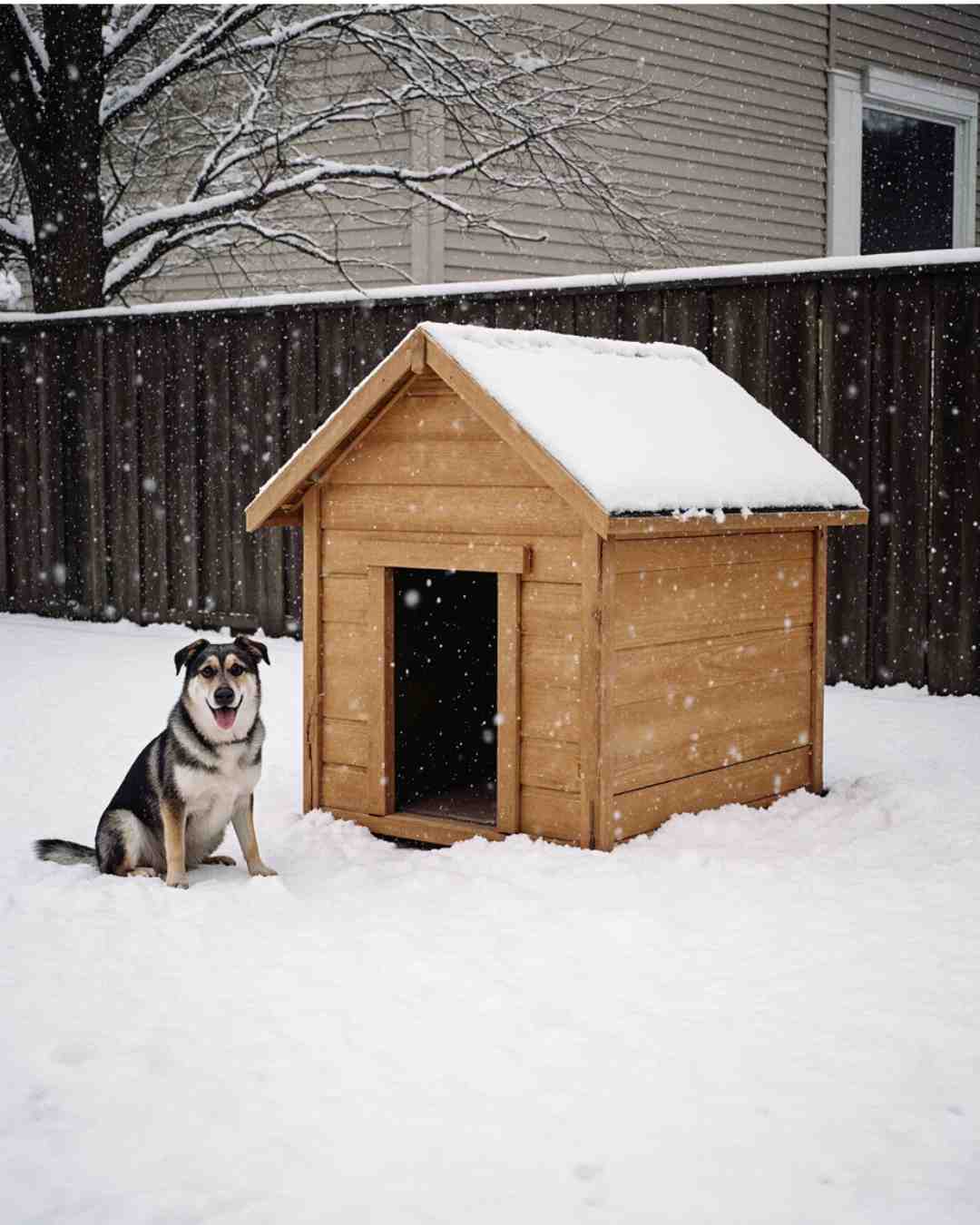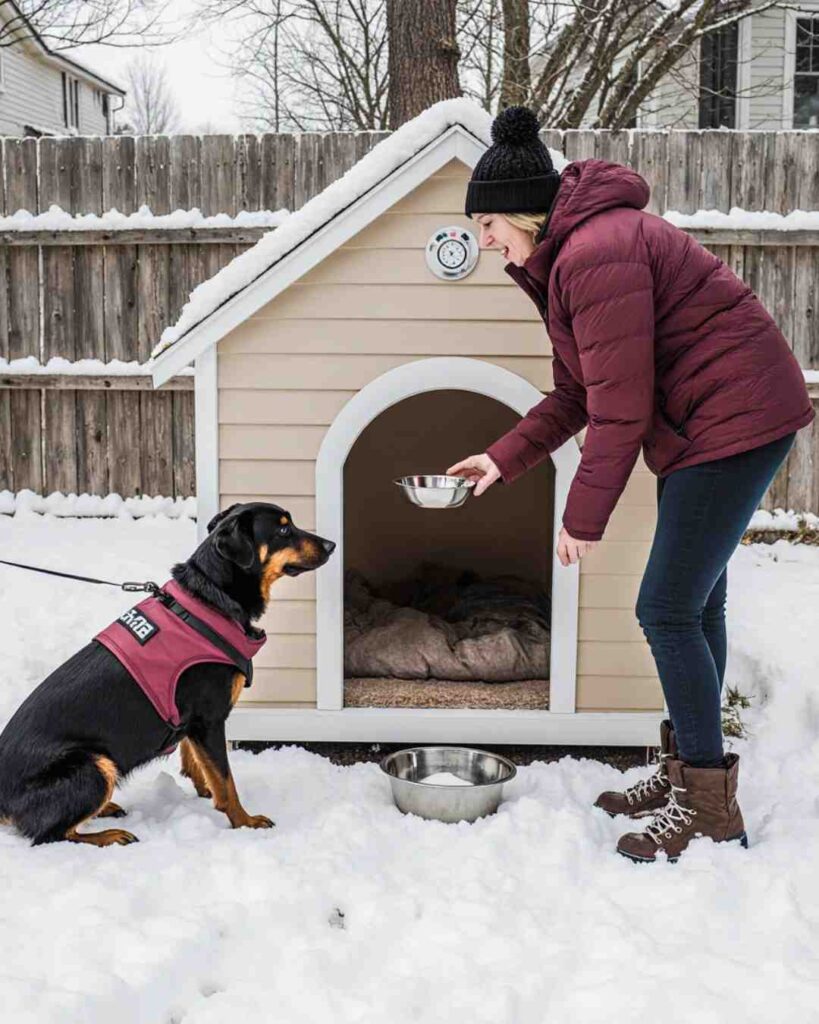Complete Winter Dog House Setup Guide: Keep Your Pup Warm & Safe
I love winter with my dog, but every time that cold air hits, I feel that punch of worry in my chest. You know that feeling? When you ask yourself, “Is my dog warm enough out there?” I’ve built more winter dog houses than I’d like to admit, and I still find myself tweaking things every year. I guess that’s what happens when you love your pup like family.
So in this guide, I’ll walk you through every single thing that has worked for me — insulation tricks, bedding setups, roofing fixes, and all the little safety details that people often forget. Think of this as two dog-obsessed friends chatting about building the perfect winter dog house that keeps your pup warm, cozy, and totally safe.
And don’t worry — I’ll keep everything super practical. No confusing technical talk. No boring textbook explanations. Just real stuff that actually works.
Why a Proper Winter Dog House Setup Matters
Cold Weather Hits Dogs Differently
I always remind myself that dogs feel the cold differently based on size, breed, and coat. A Husky basically laughs at freezing weather, while a short-haired breed looks like it’s auditioning for a “shivering puppy” movie scene the second the temperature dips.
Ever noticed how some dogs refuse to step outside when it’s freezing? They know what’s up. So why not give them a winter setup that makes them excited to go into their house?
Outdoor Dogs Need More Than Shelter
Let’s be real — putting four walls and a roof together doesn’t make a winter-ready dog house. Dogs need insulation, proper bedding, wind protection, a raised floor, and safe heating options. Miss one of these and your dog will feel it the second temperatures drop.
If you want an easy win here, a Heavy-Duty Outdoor Dog House Kit can speed up the whole build.
Choosing the Right Materials for a Winter Dog House
Why Material Quality Matters More Than Size
Over the years, I noticed one thing: the material decides whether the house stays warm or becomes an icebox by midnight. Ever sat on a wood bench in winter? Exactly. Materials either hold warmth or suck it right out.
Best Materials for a Winter Dog House
- Solid wood (cedar, fir, pine) – best insulation, long-lasting
- Thick composite wood – more budget-friendly and still warm
- Plastic houses – only work if heavily insulated; they lose heat fast
- Metal – just… no. I wouldn’t sleep in a metal shed in winter, and neither should your dog
Quick tip: Wood always wins for winter. It naturally traps heat, breathes well, and pairs perfectly with insulation layers.
If you don’t want to cut wood yourself, the Precision Pet Log Cabin Dog House is a solid premade option.
Perfect Winter Insulation Setup
This is the part most people stress about — and honestly, I get it. Insulation confused me the first time too. But once you figure out what works, everything clicks.
My Favorite Insulation Materials
Let me share the things that actually made a difference:
- Foam board insulation – lightweight, easy to cut, amazing heat retention
- Reflective insulation rolls – perfect for lining walls and redirecting heat
- Straw bales (for outside walls) – natural wind blockers
- Spray foam (minimal use) – good for cracks, but don’t overdo it
Ever wondered why foam board is so popular? Because it traps heat without absorbing moisture. Moisture is the enemy, and I learned that the hard way the winter my insulation turned into a soggy sponge.
If you want something super easy to work with, the Owens Corning Foamular Insulation Board is my go-to choice.
Insulating Walls, Floor & Roof Step-by-Step
1. Insulating the Walls
I cut foam boards to match each wall and secure them behind panels. I always check for cracks — even tiny air leaks steal warmth.
2. Insulating the Floor
The floor always gets coldest. I raise it at least 4–6 inches and add:
- A foam board layer
- A wood plank layer on top
- A waterproof mat
Why raise it? Have you ever stood barefoot on cold tile? Exactly.
3. Insulating the Roof
Warm air escapes upward, so I always double up on roof insulation. I use:
- Foam board
- Reflective insulation
- A sealed inner panel
Once I started sealing the roof tightly, the temperature inside the dog house literally jumped by several degrees.
If you like multi-step dog DIYs, you’ll also enjoy my beef bone broth recipe for winter immune support.
The Best Winter Bedding Setup
The bedding matters more than people think. I used to toss in blankets and call it a day. Oh boy, big mistake. Blankets get damp fast, and once they do, your dog might as well sleep on an ice pack.
H3: Bedding Types That Actually Work
1. Straw (Not Hay)
Straw stays dry, warm, and fluffy. Dogs love burrowing in it. Hay, on the other hand, gets moldy and stinky.
2. Cedar Shavings
These smell amazing and resist bugs. I usually mix a little into the straw layer.
3. Heated Outdoor Dog Bed
My personal favorite addition. I use a low-watt outdoor-rated heated pad during super cold nights. It stays warm but never overheats.
4. Thermal Pet Blankets
These reflect heat back to the dog. They work great on top of straw, not as the base layer.
What to avoid:
- Regular indoor blankets
- Memory foam beds
- Loose cotton stuffing
They all trap moisture.
My Exact Bedding Formula
If you want the setup that works every single time, here it is:
- Rubber waterproof mat
- 3–4 inches of straw
- Thin layer of cedar shavings
- Thermal blanket or heated pad
- Extra straw around the edges
This combo never failed me, even in freezing nights.
This combo never failed me, even in freezing nights. This is the same bedding method I use when prepping meals like my homemade beef dog food roll during winter.
Building a Warm, Wind-Safe Entrance
This part might seem small, but it’s a game-changer. Cold wind sneaks into dog houses like it’s on a mission.
Door Covers That Keep the Wind Out
I’ve tested everything, and these work best:
- Heavy vinyl flaps
- Insulated canvas flaps
- Two-layer plastic strips
- A small tunnel-style entrance
I personally love vinyl because it stays flexible even when it gets freezing outside. Ever touched stiff plastic in winter? It cracks faster than a dry branch.
If you want to upgrade yours, the GunDog House Door Vinyl Flap is incredibly durable.
Add a Windbreak Outside
I once placed a simple plywood sheet on the windy side of the dog house, and it transformed the whole setup. A windbreak cuts wind chill almost in half.
Good windbreak ideas:
- Shrubs
- Wood panels
- Straw bales
- Small fencing sections
Bold reminder: Wind protection plays a huge role in keeping warmth inside.
The Roof — Your Winter MVP
The roof decides whether heat stays inside or runs away like it owes someone money.
Roof Styles That Work Best for Winter
- Slanted roof – snow slides off easily
- Gabled roof – great airflow
- Insulated flat roof – only works if sealed perfectly
I prefer a slanted roof. Snow falls off instead of piling up and pushing cold downward.
Waterproofing the Roof
Here’s what I always add:
- Asphalt shingles (great water protection)
- Roof underlayment
- Silicone sealant around edges
Once you waterproof properly, you stop worrying about melting snow dripping into bedding.
Heating Options — The Safe and Unsafe Ones
I always get nervous about heating because most people grab whatever they find on sale. But heat sources can cause fires or carbon monoxide problems if you’re not careful.
Safe Heating Options
Here are the things I trust:
1. Outdoor-rated heated dog pads
I love these because they don’t overheat and they’re designed specifically for pets.
2. Self-warming thermal beds
They reflect body heat and never plug in — super safe.
3. Insulated microwavable heat discs
I use these when I don’t want electricity involved.
4. A properly set up heat bulb
Only if it’s:
- Ceramic
- Enclosed
- Out of reach
- Fixed firmly
Ever tried installing one of these without a cover? I did once. Never again.
Heating Options to Avoid
- Space heaters
- Propane heaters
- Kerosene heaters
- Candles (someone actually asked me once, no joke)
- Anything not rated for pet use
If you go electric, the K&H Outdoor Heated Kitty Pad (Yes, dogs use it too!) is surprisingly safe and reliable.
If it can tip over or release fumes, I don’t even consider it.
Ventilation — The Secret Ingredient Most People Miss
Ventilation sounds boring, but it saves your dog from humidity, mold, and respiratory issues.
Why Ventilation Matters in Winter
Ever slept in a warm room with no airflow and woke up with a stuffy nose? Dogs feel that too. Warm air + moisture from breathing leads to damp bedding, and damp bedding leads to cold sleeping conditions.
How to Ventilate Properly Without Losing Heat
- Add two small vents high on opposite walls
- Make vents adjustable so you control airflow
- Keep vents above bedding height
- Ensure wind doesn’t blow directly into vents
Once I added adjustable vents, I noticed that my dog’s bedding stayed dry way longer.
If you want to explore more dog-care content, you can check my dog training tips category.
Winter Safety Tips Every Dog Owner Must Know
Temperature Monitoring
I installed a small wireless thermometer inside the dog house. Best decision ever. You know exactly when temperatures drop too low.
If you need one, the Govee Wireless Indoor Thermometer works perfectly for dog houses.
Check Bedding Weekly
Straw settles and compresses. I fluff and replace it regularly so it stays warm and soft.
Snow and Ice Management
I shovel a path so my dog doesn’t slip or slide every time he steps outside. Nobody wants a dog doing unplanned skating tricks.
Hydration Matters Too
Dogs drink less in winter. I use a heated water bowl to prevent freezing. Ever tried giving your dog a block of ice to drink? Not fun.
Avoid Electric Cords in Reach
Dogs chew. It happens. I hide every cable inside a protective cord cover.
Fun note: This is where I drop my one slang moment — don’t give your dog a chance to “yeet” the cord across the yard. You only get one of these, so there it is.
My Favorite Add-Ons for a Perfect Winter Dog House
Let me share the little upgrades that made my winter setups feel premium.
1. Reflective emergency blanket layer under the roof
It traps heat surprisingly well.
2. Anti-draft door sweep at the entrance
Works like magic.
3. Small solar-powered LED light
Helps you check inside at night.
4. Removable inner wall panels
Perfect for spring cleaning.
5. Cozy corner bed setup
Dogs love corners; they feel safe and warm there.
Conclusion
At the end of the day, we all want the same thing — a dog house that keeps our pups warm, safe, and totally comfortable through winter. I’ve tested every setup you just read about, and I promise that if you combine proper insulation, warm bedding, a tightly sealed roof, and safe heating, your dog will have a winter hideaway that feels like a personal cabin retreat.
And remember, no setup stays perfect forever. Keep checking, tweaking, and improving. Your dog will always thank you with that adorable tail wag that makes every hour of effort worth it.
So what’s your next move? Will you upgrade your dog’s roof, swap the bedding, or install a heated pad? Whatever you decide, you’re already doing more than most — and your dog feels that love every single day.





